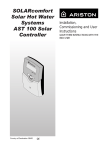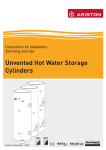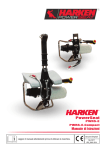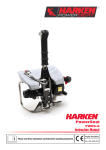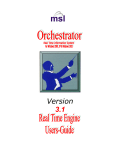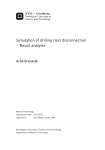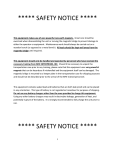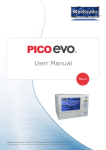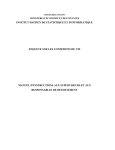Download Ariston SOLARcomfort Technical data
Transcript
SOLARcomfort Solar Hot Water Systems Pump Group Instructions for Installation and Servicing LEAVE THESE INSTRUCTIONS WITH THE END USER Country of Destination GB/IE TABLE OF CONTENTS 1. 1.1 1.2 1.3 1.4 1.5 1.6 GENERAL INFORMATION ................ 2 GUARANTEE .......................................... 2 SYSTEM CONTENTS ................................ 2 SYSTEM INSTRUCTION BOOKS ................... 2 SOLARCOMFORT .................................. 3 LIFESTYLE ............................................. 3 HOW THE SYSTEM WORKS ....................... 3 2. SAFETY ............................................. 6 3. 3.1 3.2 3.3 3.4 TECHNICAL DATA ............................. 7 TEMPERATURE/PRESSURE ........................ 7 COMPONENT LIST ................................... 8 PUMP GROUP DIMENSIONS ...................... 9 EXPANSION VESSEL DIMENSIONS ............... 9 4. 4.1 4.2 4.3 4.4 4.5 4.6 4.7 4.8 4.9 4.10 REGULATIONS & STANDARDS...... 10 WATER REGULATIONS ........................... 10 BUILDING REGULATIONS ......................... 10 GENERAL GUIDANCE ............................. 10 BRITISH & EUROPEAN STANDARDS .......... 11 UK REGULATIONS (WATER HEATING) ...... 11 UK REGULATIONS (CONSTRUCTION) ........ 11 EU DIRECTIVES ................................... 12 OTHER PUBLICATIONS ........................... 12 ELECTRICAL CONNECTION ...................... 12 THERMAL INSULATION ............................ 12 5. 5.1 5.2 5.3 INSTALLATION ................................ 13 FITTING FLOW LIMITER .......................... 13 POSITIONING PUMP GROUP .................... 13 CONSIDERATIONS FOR POSITIONING PUMP GROUP ............................................... 14 PIPEWORK AND FITTINGS ....................... 14 INSULATION .......................................... 14 SIZING OF PIPES .................................. 15 PIPEWORK ........................................... 15 ELECTRICAL CONNECTIONS .................... 15 TWO COLLECTOR SCHEMATIC ................. 17 THREE COLLECTOR SCHEMATIC .............. 17 WALL MOUNTING MODULES ................... 18 CONNECTING PIPEWORK ........................ 19 PIPE REDUCERS .................................. 20 EXPANSION VESSEL .............................. 20 PRESSURE RELIEF VALVE ...................... 21 FILLING POINT ..................................... 22 FLOW REGULATOR ................................ 22 5.4 5.5 5.6 5.7 5.8 5.9 5.10 5.11 5.12 5.13 5.14 5.15 5.16 5.17 6. COMMISSIONING SYSTEM ........... 23 6.1 PRE-FILL CHECK .................................. 23 6.2 FLUSHING AND FILLING THE SYSTEM USING GLYCOL .............................................. 24 6.3 FLUSHING THE SYSTEM USING WATER ...... 26 6.4 FILLING AND TOPPING UP THE SYSTEM WITH GLYCOL .............................................. 28 6.5 SYSTEM PRESSURE .............................. 30 6.6 COMMISSIONING SHEET ......................... 31 7. MAINTENANCE SCHEDULE .......... 32 1 this will be page 1 1. GENERAL INFORMATION This manual is an integral and essential part of the product. It should be kept with the product. Please read carefully the instructions and notes about SOLARcomfort contained in this manual as they provide important information regarding the safe installation of the Pump Group. IMPORTANT Failure to follow these instructions correctly may invalidate the guarantee. IMPORTANT Solar domestic hot water heating systems must be installed to comply with the current Building Regulations, British Standards and any applicable local regulations. 1.1 GUARANTEE The SOLARcomfort Pump Group is guaranteed for 2 years against munufacturing defect - see terms and conditions of guarantee on back page. 1.2 SYSTEM CONTENTS The complete SOLARcomfort solar water heating system is supplied in the following consignments:1. Ref. 800201 Collector 2. Ref. 3107024/5 Roof Fittings Kit 3. 3820011/2 System Components 4. 3820001 1.3 SYSTEM INSTRUCTION BOOKS 2 1 per box 1 cardboard tube 1 box Tyfocor anti freeze heat transfer fluid 1 x 20l container The following instruction booklets are supplied with a complete SOLARcomfort solar water heating system:1. SOLARcomfort Solar Hot Water Systems Collectors 2 & 3 Collector Set. Covers collector installation and plumbing connection. Supplied in System Components box. 2. SOLARcomfort Solar Hot Water Systems Pump Group 40/60. Covers installation, plumbing connection, system filling, flushing and commissioning. Supplied in System Components box. 3. Solar Controller AST100 Covers installation, wiring connection and User Instructions. Supplied in System Components box. 1.4 SOLARCOMFORT SOLARcomfort systems are highly efficient and provide cost savings on the energy used for heating hot water wherever they are used in the UK. However, the savings made will depend on local climate, installation characteristics and the households use of hot water. It is important that the SOLARcomfort system is correctly sized for the local climate condition and the household’s domestic hot water requirements. 1.5 LIFESTYLE After installation of the SOLARcomfort system, changes to the householders use of hot water will be beneficial. Simple changes such as bathing in the evening instead of the morning, and putting automatic washing machines on when free hot water is available by solar energy. In addition, the timing of the dwelling’s boiler controls must be modified to ensure the ‘hot water ON’ time is set so that the water temperature in the cylinder is at a minimum by the start of the ‘solar day’. 1.6 HOW THE SYSTEM WORKS See fig. 1.6A The solar collectors are heated by the sun’s rays. The heat generated is stored in a hot water storage cylinder e.g. an Ariston Primo twin coil stainless steel cylinder. The AST 100 Solar Controller continually compares the temperature of the water within the cylinder with the temperature of the solar collectors. Whenever the solar collectors are hotter than the water within the cylinder, the controller switches on the system’s circulating pump. The temperature differential between the collectors and the cylinder is set via the AST100 Solar Controller. The heat transfer fluid within the solar system is then circulated through the collectors and the cylinder’s heat exchanger, heating the cylinder in just the same way as a central heating boiler. The cylinder typically has two coils (heat exchangers), the lower coil is heated by the solar system, therefore solar is the primary heat source. The upper cylinder is heated by an auxiliary heat source, typically a central heating boiler, which is used to heat water when there is insufficient heat generated by the solar system. The Ariston Primo twin cylinder also has two immersion heaters making it suitable for electric only heating systems. The SOLARcomfort system is a forced circulation sealed system and therefore requires an expansion vessel and a pressure relief valve (PRV), both supplied with SOLARcomfort. The air separator with an integral air vent together with an automatic air vent positioned at the highest point on the system ensures that the sealed system remains free of air. 3 Roof mounted collectors (two collector system shown) Air vent Energy Monitoring Sensor S4 (option) Temperature Sensor S1 Ariston ITSI 210/300 twin coil cylinder AST 100 Controller PR Valve Pump group Temperature Sensor S3 Expansion vessel Upper coil heated by boiler or other heat source Temperature Sensor S2 PRV discharge vessel Solar system low level fill point Lower coil heated by solar energy FIG. 1.6A BASIC PRINCIPLES 4 Solar system drain point Flow 1. 2. 3. 4. Insulated Cover Flow from Solar Collectors Flow Temperature Gauge Flow Shut Off Valve c/w non return valve -red Knob 5. 6. 7. 8. 9. Air Separator Manual Air Vent Return to Solar Collectors Return Temperature Gauge Return Shut Off Valve c/w non return valve -blue Knob Return 10. 11. 12. 13. 14. 15. 16. 17. 18. 19. 20. Circulating Pump System Fill and Drain Point Fill and Drain Shut Off Valve Flow Limiter Flow Limiter Adjustment Screw Non-return Valve Non-return Valve Shut Off Expansion Vessel Connection Pressure Relief Valve (PRV) PRV Outlet System Pressure Guage FIG. 1.6B PUMP GROUP COMPONENTS 5 2. SAFETY WARNING The pump group must be correctly fitted to the wall using the bracket supplied. It should not be supported by the connecting pipework alone. WARNING During operation and commissioning the temperature of the heat transfer fluid within the system and collectors can reach temperatures high enough to present a risk of scalding. Never loosen fittings or open vents when the system is hot. WARNING TYFOCOR LS Heat Transfer Fluid. Although non-toxic it should not be swallowed. Refer to label on its container for storage and safety information. A detailed technical specification is available from Ariston on request. Caution SOLARcomfort should be installed and commissioned by approved contractors. Failure to do so may invalidate the warranty. Caution The pump group should be positioned so that it is inaccessible to children and cannot be tampered with. 6 3. TECHNICAL DATA PUMP MODULE Pipe connection 22mm Reducers supplied 15mm Pump type 15/40 Maximum operating pressure Electrical Cable 0.6MPa 1.0mm² 3 core heat resistant flex 3093Y to 85°C Cover Moulded polystyrene AIR SEPARATOR MODULE Pipe connection 22mm Reducers supplied 15mm Maximum operating pressure Cover 0.6MPa Moulded polystyrene EXPANSION VESSEL 2 & 3 collector systems 25l Optional size (code 12002737) 35l Maximum pressure 10 bar Pre-charge pressure 2.5 bar PRESSURE RELIEF VALVE Setting 6 bar Discharge ½” BSP - Ø15 pipe HEAT TRANSFER FLUID Type Tyfocor LS Use undiluted 3.1 TEMPERATURE / PRESSURE 100% Weight 1.04kg/l Frost protection to -28°C Operating pressure and temperature must be within the limits depicted by the hatched area Operating temperatures above 100°C as depicted by the shaded area must be avoided for continuous operation FIG. 3.1A TEMPERATURE PRESSURE DIAGRAM 7 3.2 COMPONENT LIST Listed below are all the components required to fit the pump group. Item Description 1 Pump Group 2 Flow Limiter Components (see 5.1) 3 Wall Mounting Bracket 1 4 Screw 1 5 Wall Plug 1 6 Expansion Vessel 25l standard (35l option) 1 7 Expansion Vessel Fixings 1 8 Flexible Connector 1 FIG. 3.2A PUMP GROUP COMPONENT LIST 8 Qty 1 1 set 3.3 PUMP GROUP DIMENSIONS FIG. 3.3A PUMP GROUP DIMENSIONS 3.4 EXPANSION VESSEL DIMENSIONS Maximum pressure Pre-charge pressure 10 bar 2.5 bar 25 Litre (standard) 35 Litre (optional: code 12002737) FIG. 3.4A EXPANSION VESSEL DIMENSIONS 9 4. REGULATIONS & STANDARDS SOLARcomfort hot water heating systems should be installed in compliance with the following standards and regulations. 4.1 WATER REGULATIONS Water Supply (Water Fittings) Regulations 1999 / www.wras.co.uk These regulations (bye-laws in Scotland) ensure a good supply of wholesome water and that only approved materials, pipes and fittings are used to convey water. 4.2 BUILDING REGULATIONS These are statutory documents and take priority over all other regulations and recommendations. The installation of an unvented hot water storage cylinder is classified as a “Controlled Service” and Regulation G3 applies. To meet the requirements of the Regulations, installation of an unvented system should be undertaken by a “competent installer”. All installations of unvented hot water storage systems having a capacity of more than 15 litres should be notified to the relevant Local Authority by means of a building notice or by the submission of full plans. It is important to note that it is a criminal offence to install an unvented hot water storage system without notifying the Local Authority. The installation of the unvented cylinder and hot water system must comply with BS 6700 and the HSE Legionella Code of Practice. 4.3 GENERAL GUIDANCE Current guidance notes do not cover the connection of a solar thermal circuit to an unvented storage vessel (cylinder). However, if guidance is sought for compliance with current regulations the fundamental principle is to provide a fail-safe means of shutting off the solar input to the heat exchanger if the cylinder temperature should rise above the set temperature of the cylinder’s energy cut out. (See Note 1). As with all unvented hot water systems, notification of intention to install should be given to your local building control. Option A. A non self-resetting mechanical shut-off should be installed on the solar primary flow to the cylinder. The mechanical shut-off should be suitable for use with a solar primary circuit (i.e. high temperature and glycol resistant). The mechanical shut-off should be integrated electrically with the cylinder energy cut out/s and if necessary the solar circuit temperature control, please refer to the solar controller manufacturer for further information. Option B. Where the solar controller and hydraulic system demonstrate that by no lesser means the requirement in Option A is satisfied by other means; certification by an approvals body is required to demonstrate that in the event of the stored water going over temperature, the heat input to the cylinder is isolated by physical means and is non self-resetting. These systems should be clearly identified with reference to the approvals body. (See Note 2). Note 1 : Whilst most solar cylinders use a coil type heat exchanger other options such as external plate to plate devices, external annulars or ‘tank in tank’ systems may be used but the same control options always apply. Note 2 : Current approved bodies include the British Board of Agrèment (BBA), WRc-NSF Limited, or KIWA. 10 4.4 BRITISH & EUROPEAN STANDARDS Connection of thermal solar heating systems EN 12976: Thermal solar heating systems and their components (prefabricated systems). ENV 12977: Thermal solar heating system and their components (bespoke systems). BS5918: Latest version: Solar heating systems for domestic hot water. Installation and equipment of DHW cylinders BS5546: 2000 Specification for installation of hot water supplies for domestic purposes, using gas-fired appliances of rated input not exceeding 70 kW. BS6700: 1997 Specification for design, installation, testing and maintenance, of servicing, supplying water for domestic use within buildings and their curtilages. The local water company by-laws. Electrical connection Current IEE wiring regulations. Health and Safety document No 635 (Electricity at Work Regulations) 4.5 UK REGULATIONS PARTICULARLY RELEVANT FOR WATER HEATING EQUIPMENT 4.6 UK REGULATIONS PARTICULARLY RELEVANT FOR CONSTRUCTION The Pressure Equipment Regulations (PED) 1999 - www.eurodyn.com The Building Regulations (L1 A&B) 2006 and Domestic Heating Compliance Guide - www.communities.gov.uk The Building Regulations (P) 2005 - www.communities.gov.uk Control of Substances Hazardous to Health Regulations (COSHH) 1994 www.hse.gov.uk Further details available from: www.hse.gov.uk Health & Safety At Work Act (HSW) 1974 Work at Height Regulations 2005. Reporting of Injuries, Diseases and Dangerous Occurrences Regulations (RIDDOR) 1995. Management Health & Safety at Work Regulations (MHSWR) 1999. Noise at Work Regulations 1989. Construction (Health, Safety & Welfare) Regulations (CHSWA) 1996. Electricity at Work Regulations 1989. Construction Regulations (Head Protection) 1989. Control of Substances Hazardous to Health Regulations (COSHH) 1994. Construction (Design and Management) Regulations (CDM) 1994. Personal Protective Equipment at Work Regulations 1992. Lifting Operations and Lifting Equipment Regulations (LOLER) 1998. Confined Spaces Regulations 1997. Manual Handling Operations Regulations 1992. The Workplace (Health, Safety and Welfare) Regulations 1992 (WHSWA). Provision and Use of Work Equipment Regulations (PUWER) 1998. Health and Safety (First Aid) Regulations 1981. LZC - Low or zero carbon energy sources: strategic guide. 11 4.7 EU DIRECTIVES Further details available from: www.europa.eu.int Construction Directive: 89/106/EEC Electromagnetic: 89/336/EEC Low voltage: 73/23/EEC Machinery Directive: 98/37/EC 4.8 OTHER Preventing hot water scalding in bathrooms: using TMVs (IP 14/03). DTI testing of solar systems (SP300275 1-3). Review of issues related to active solar heating systems (SP300246). Active solar performance and data review (SP300270). Solar heating systems for hot water (BS 5918). Hard water scale in hot water storage cylinders (IP13/93). Heating systems in buildings – design for water-based heating systems (PrEN 12828). Building log books (GPG 348). Solar heating (CIBSE DBSP WGG). Sun in Action II (ESTIF – Sun in Action II). Minimising the risk of legionnaires’ disease (TM 13). BRE Digest 489. Energy Saving Trust - www.est.org.uk CE131 Solar Water Heating Systems - Guidance for professionals, conventional indirect models. PUBLICATIONS 4.9 ELECTRICAL CONNECTION BS7671 2001 Amended 2004 APD P: P1 - Design, Installation, Inspection and Testing P2 - Provision of information 4.10 THERMAL INSULATION Thermal Insulation Standard TIMSA (Thermal Insulation Manufacturers and Suppliers Association). 12 5. INSTALLATION 5.1 FITTING FLOW LIMITER A flow limiter set is supplied separately, this must be fitted to the pump group on the suction side of the pump as shown in fig. 5.1a. Note: The flow limiter is supplied with fittings for 15Ø pipe. 15Ø FIG. 5.1A FITTING FLOW LIMITER 5.2 POSITIONING PUMP GROUP To Collector Temperature Sensor S1 From Collectors To Collectors AST 100 Controller Expansion Vessel Cylinder S3 Fill point Pump Group S2 PRV discharge vessel FIG. 5.2A SUGGESTED LOCATION 13 5.3 CONSIDERATIONS FOR POSITIONING PUMP GROUP The pump group and should normally be wall mounted in close proximity to the cylinder. Fig. 5.2A gives a typical layout. The AST100 Solar Controller should be positioned so that the householder has easy access with good visibility of the display. Also, consideration has to be given to routing for connection to the pump group, cylinder and collector temperature sensors. Cables supplied with the sensors and control unit are nominal length and Consideration should be given to the following when selecting a position for pump group:1. The pump group should be placed close to the storage cylinder to keep pipe runs to a minimum. 2. The pump group and pipework should have easy access with good visibility for changing settings and all necessary maintenance work. 3. The pump group and controller should be positioned so that they are inaccessible to children and cannot be tampered with. may require terminal boxes and extra cable lengths to make connections. 5.4 PIPEWORK AND FITTINGS Taking into account the heat transfer fluid within the system may reach high temperatures, the primary circuit should be copper, stainless steel (rigid and flexible) or carbon steel braided high temperature hose. Pipe joints and connections with other system components should also be able to withstand the working temperatures and pressures. Thought should be given to preventing corrosion due to dissimilar metals in contact. All copper pipework must be Kite Marked BS EN1057 1996 Table X half hard copper tube. All fittings must be quality brass BS864-2 compression type. Brass olives are recommended as they produce a better seal. Brazed or silver soldered joints are acceptable. The use of joint compounds such as ‘Fernox White’ is recommended for compression joints. Owing to the high temperatures of the solar system, plastic pipe and fittings must not be used. All fittings and components fitted must be able to withstand temperatures in excess of 150°. Soldered and push fit fittings should not be used. Galvanised steel pipe should not be used. 5.5 INSULATION All external pipework, connections and fittings must be insulated with suitable high temperature, vermin resistant and UV resistant insulating materials. All internal pipework (excluding pipework to the expansion vessel) must be insulated with suitable high temperature insulating materials. Insulation of the pipework must only be undertaken after tightening of the compression fittings and completion of a pressure test - see section 6. 14 5.6 SIZING OF PIPES The flow rate in the circuit is between 0.5 and 1.5 litres/min for each collector. The flow velocity in the circuit should not exceed 1.5m/sec otherwise the the system may be noisy during operation. As a guide only: systems with total pipework of less than 50 metres, 15mm diameter pipe should allow flow conditions to be met for systems with up to four collectors. When the total pipework is over 50 metres, then 22mm pipe should be used. An assessment of the specific installation requirements must be undertaken. 5.7 PIPEWORK 5.8 ELECTRICAL CONNECTIONS The installation of pipework must be made in accordance with good plumbing practice, the following points should be considered when installing pipework. 1. Pipe runs should be chosen to give the shortest most direct route to the storage cylinder, with minimum bends. Tight bends should be avoided. 2. The falls of pipes should be arranged to allow the system to be drained and vented. Low points, when unavoidable, should be fitted with a drain. High points, when unavoidable, should be fitted with a vent. 3. Where possible, all pipe runs should have a continuous slight incline up to the highest point in the system to allow for natural venting of air from the system. 4. The automatic air vent supplied with the system should be fitted to the highest point i.e. near the flow connection of the collectors. 5. Adequate support and fixing should be provided for all pipework to ensure that inclines are maintained and sagging is prevented. 6. Owing to the high temperature differentials within the solar circuit consideration should be given to the expansion of the pipework, expect up to 12mm on a 5 metre run. Pipes should be fitted with brackets and devices that allow for expansion and contraction, rigid fixings should be avoided. 7. A drain point must be fitted at the lowest point of the solar circuit. It must be positioned at the down side of the non-return valve to ensure the system can be fully drained. All electrical connections must comply with current IEE Regulations. The Pump is the only electrical connection for the Pump Group. This is connected to the AST100 Controller’s R1 terminals via the cylinder manual reset thermostat (thermal overload), refer to wiring diagram in the AST100 Solar Controller instructions. 1. 2. 3. 4. 5. 6. The pump must be connected using 1.0mm² 3 core heat resistant 3 core flex 3093Y marked at least to tolerate 85°. All cable sheath clamps must be correctly fitted. The conductor sheath must be continuous into joint enclosures. Conductors must be correctly fastened to terminals. Conductor insulation to be within 2mm of terminals All cable conductors external to joint enclosures must be insulated and sheathed. 15 5.9 TWO COLLECTOR SCHEMATIC Cylinder 1. 2. 3. 4. 5. 6. 7. 8. 9. 10. 11. 12. Collector System Pressure Guage Pump Group Automatic Air Vent Flow Temperature Gauge Shut Off Valve Circulating Pump Flow Limiter Non-Return Valve Pressure Relief Valve (PRV) PRV Discharge Vessel Return Temperature Gauge FIG. 5.9A TWO COLLECTOR FLOW DIAGRAM 16 13. 14. 15. 16. 17. 18. 19. 20. 21. 22. 23. Air Separator with Manual Air Vent Expansion Vessel Solar AST 100 Controller Upper Cylinder Temperature Sensor (S3) Lower Cylinder Temperature Sensor (S2) Collector Temperature Sensor (S1) System Fill Point (flow) System Fill Point (return) System Drain Cylinder - twin coil shown Boiler (auxiliary heat source) 5.10 THREE COLLECTOR SCHEMATIC Cylinder 1. 2. 3. 4. 5. 6. 7. 8. 9. 10. 11. 12. Collector System Pressure Guage Pump Group Automatic Air Vent Flow Temperature Gauge Shut Off Valve Circulating Pump Flow Limiter Non-Return Valve Pressure Relief Valve (PRV) PRV Discharge Vessel Return Temperature Gauge 13. 14. 15. 16. 17. 18. 19. 20. 21. 22. 23. Air Separator Manual Air Vent Expansion Vessel Solar AST 100 Controller Upper Cylinder Temperature Sensor (S3) Lower Cylinder Temperature Sensor (S2) Collector Temperature Sensor (S1) System Fill Point (flow) System Fill Point (return) System Drain Cylinder - twin coil shown Boiler (auxiliary heat source) FIG. 5.10A THREE COLLECTOR FLOW DIAGRAM 17 5.11 WALL MOUNTING MODULES See fig. 5.11A The pump module is supplied with a wall bracket. The pump group must be correctly fitted to the wall using the bracket supplied. It should not be supported by the connecting pipework alone. FITTING PROCEDURE 1. Determine the best location for the pump group, take into consideration the following:i Access for fill and drain. ii Position of the expansion vessel. iii Position of the PR Valve. iv Provision has to be made for the discharge of the PR Valve to be collected in a suitable container. v Ease of plumbing to cylinder and collectors. 2. Mark position for mounting bracket. 3. Drill one holes for wall plug (if used). 4. Screw on bracket to wall and level. 5. Mount pump group onto bracket as shown in fig. 5.11a. 6. Tighten Locknuts Wall Plug Bracket Lock Nut Lock Nut Bracket FIG. 5.11A MOUNTING PUMP GROUP 18 5.12 CONNECTING PIPEWORK Automatic Air Vent Shut Off valve Pipes Ø15mm or Ø22mm see 5.% C PR Valve A Expansion Vessel D B PR Valve relief plumbed to low level Ø15mm PRV discharge vessel Flow C Return A System Drain D FIG. 5.12A CONNECTING PIPEWORK B 19 5.13 PIPE REDUCERS The basic pipe size for the system is either Ø22mm or Ø15mm see section 5.5. The collectors connections and three of the four pump group connections are supplied for Ø22mm pipe. The flow limiter has a Ø15mm connection. Compression fittings Ø22 to Ø15 will need to be fitted as required to suit system pipe size. Ø15mm Pipe Ø22mm Pipe FIG. 5.13A PIPE REDUCERS 5.14 EXPANSION VESSEL Note: Owing to high differentials in temperature within the solar circuit and the use of water/glycol mixture, expansion vessels are larger than comparable heating systems. Both two and three collector systems are supplied with a 25l expansion vessel. A 35l expansion vessel is available as an optional extra, code: 12002737. A flexible connection pipe is supplied for connection of the expansion vessel. The pump group has a dedicated expansion vessel connection point -see fig. 5.14A. Alternatively the expansion vessel can be fitted using a T fitting to the return pipework to the collectors, preferably close to the pump. Expansion vessels must not be fitted to the flow pipework owing to potential high temperatures. No manual isolation valves are permitted in the pipework to the expansion vessel. Flow Return Expansion Vessel Connection FIG. 5.14A EXPANSION VESSEL CONNECTION POINTS 20 The chart below gives the initial pressure charge that the expansion vessel will require for a given system height (static system head). The expansion vessel should be charged to this pressure prior to filling the system. The factory set pressure of vessels is 2.5 bar. System height 5.15 PRESSURE RELIEF VALVE (metres) System filling pressure (metres) 3 to 1 0 Pre-pressure of Expansion Vessel 2 5 l Ve s s e l 3 5 l Ve s s e l 1 .5 1 .3 1 .4 11 1 .6 1 .4 1 .5 12 1 .7 1 .5 1 .6 13 1 .8 1 .6 1 .6 14 1 .9 1 .7 1 .7 15 2 .0 1 .8 1 .8 s ta n da r d o ptio n a l A Pressure Relief Valve (PRV) is supplied with the system. The pump group has a dedicated PRV connection point -see fig. 5.15A. Note: The PR valve is factory set at 6bar. Alternatively the PRV can be fitted to any part of the system using an appropriate T fitting. The PRV discharge should be plumbed to a low level and terminated inside a suitable container to collect any discharged heat transfer fluid. The discharge and container should be inside the dwelling normally under the pump group - see figs. 5.1A and 5.15A. No manual isolation valves are permitted in the pipework to the PRV or in the PRV discharge pipe. Pressure Relief Valve PRV Discharge FIG. 5.15A PRESSURE RELIEF VALVE 21 5.16 FILLING POINT The system is filled with heat transfer fluid, this is pumped into the system via a filling point. The pump group has dedicated filling points - see fig. 5.16A. Alternatively a filling point can be created at any low level part of the system using an appropriate non return valve and shut-off valve arrangement. Filling Point Alternative Filling Point (return) FIG. 5.16A PRESSURE RELIEF VALVE 5.17 FLOW REGULATOR The flow regulator controls the flow rate at which the heat transfer fluid is circulated in the system. To adjust the flow, turn the adjusting screw. The flow rate should be set to suit the number of collectors, the cylnder’s heat exchanger surface area and specific installation requirements. Recommended settings when using Ariston Primo Twin cylinder are:2 Collector system 0.5 to 1.7 l/min 3 Collector system 0.5 to 2.6 l/min Flow Regulator Adjusting Screw Flow Setting Litres/min FIG. 5.17A FLOW ADJUSTMENT 22 6. COMMISSIONING SYSTEM 6.1 PRE-FILL CHECK IMPORTANT All fittings used must be suitable for temperatures in excess of 150°C. Flushing and commissioning should only be carried out when:1. No sun is shining on the collectors e.g. early in the morning, evening or when the collectors are covered. 2. Temperatures are not near freezing or there no is risk of frost. Before filling the system carry out the following pre-fill check. 1. Check collectors have been fitted correctly. 2. Check all roof tiles are replaced and secure. 3. Check weatherproofing of roof access pipework. 4. Check all pipework connections are correct and fully tightened. 5. Check all pipework is fully supported. 6. Check all manual air vents are closed. 7. Check automatic air vents are open. 8. Check isolation valve to automatic air vent is open. 9. Check expansion vessel connection and that the pipework to it is free from any valve or restriction. 10. Check pressure relief valve is correctly fitted. 11. Check PRV discharge is fitted correctly and that a suitable collecting vessel is in place. 12. Check that the indirect cylinder has been filled. 13. Check that there are no valves or restrictions in the PRV discharge. 14. Check connections to the cylinder. 15. Check that an automatic air vent is fitted at the highest point in the system, this will normally be adjacent to the collector flow. 16. Check that any high points/potential air traps in the pipework are fitted with a suitable automatic air vent. 17. Check drain points are closed. 18. Open all isolating valves within the circuit. 19. Check the pre-pressure of the expansion vessel - see 5.12. 20. Check equipotential bonding is fitted where required. 21. The pump is correctly wired and earthed. 22. Check all wiring is to current IEE regulations and BS7671. 23 6.2 FLUSHING AND FILLING THE SYSTEM USING GLYCOL To remove any contaminants, the solar system has to be flushed with heat transfer fluid or water prior to final filling, for water flush see 6:3. Flushing and filling with glycol is done using a suitable electric pump or hand pump which should be able to provide pressure up to 3.5 bar. Flushing Procedure using glycol - refer fig. 6.2A IMPORTANT The indirect cylinder MUST be fully filled before filling the solar circuit. Failure to do so may result in irreparable damage to the cylinder. 1. 2. 3. 4. 5. 6. 7. 8. IMPORTANT Tyfocor LS heat transfer fluid is premixed and must not be further diluted. 9. 10. 11. 12. 13. 14. 15. 16. 17. 18. 19. 20. 21. 22. 23. 24. 24 Carry out the pre-fill check - see 6.1. Remove pump group cover. Connect fluid flow pipe to fill connection A. Connect return flushing pipe to connection B. Open valves C then D. Open non-return valve shut off E. Check the flow shut off valve with integral temperature guage F is open, the red housing should be vertical (90°CW) as shown. Check the return shut off valve with integral temperature guage G is open, the blue housing should be vertical (90°CW) as shown. Set Flow Rate to maximum H (slot vertical) - see 5.16. Close air bleed valve J. Open the air vent(s) at the system high point(s). Start pumping fluid through the system. As the pumped fluid will take the route of less resistance it will flow through the pump and then return to the container. After a short period close the ball valve G by turning the blue thermometer housing (CCW). This will divert the flow in the normal direction of the system. When flushing is complete close valve C (flush return). The system will now start to fill. Fill the system slowly to encourage air to escape. Raise the system pressure to 3.5 Bar to improve air removal and to check all connections are sound. Switch off filling pump, close valve D and remove filling pipe. Check air bleed valve J for air. Check system for leaks. Return system pressure to the required ‘system fill pressure’ as shown on chart 6.5. Ensure the non-return valves, flow limiter, all ball valves and other shut off devices are returned to their correct position. When all air has been evacuated from the system close the automatic air vent and associated isolation valves. Set Flow Rate at H to 1l/min - see 5.16. Refit pump group cover. Replace all thermal insulation and ensure all external and internal pipework and fittings are suitably insulated - see 5.4. Flow Return System Pressure Gauge PRV Discharge To Expansion Vessel Pump 3.5 Bar minimum Heat Transfer Fluid FIG. 6.2A PUMP GROUP FLUSHING (GLYCOL) AND FILLING 25 6.3 FLUSHING THE SYSTEM USING WATER IMPORTANT The indirect cylinder MUST be fully filled before filling the solar circuit. Failure to do so may result in irreparable damage to the cylinder. To remove any contaminants, the solar system has to be flushed with heat transfer fluid or water prior to final filling, for glycol flushing and filling see 6:2. Flushing and filling with water can be done using a conventional filling loop from the mains supply. The mains pressure must be capable of pressurising the system to 3.5 bar. If 3.5 Bar is not achievable from a filling loop a suitable electric pump or hand pump which should be used. Flushing Procedure using water - refer fig. 6.3A IMPORTANT After the system has been flushed with water it must be completely drained of water before filling with glycol to ensure the glycol fill is of the correct concentration. 1. 2. 3. 4. 5. 6. 7. 8. 9. 10. 11. 12. 13. 14. 15. 16. 17. 18. 19. 20. 21. 22. 23. 24. 26 Carry out the pre-fill check - see 6.1. Remove pump group cover. Connect one end of the water flow pipe to fill connection A, the other end is either connected to a mains filling point, or to a pump arrangement. Connect return flushing pipe to connection B, the other end either goes to a drain or suitable collector. Open valves C then D. Open non-return valve shut off E. Check the flow shut off valve with integral temperature guage F is open, the red housing should be vertical (90°CW) as shown. Check the return shut off valve with integral temperature guage G is open, the blue housing should be vertical (90°CW) as shown. Set Flow Rate to maximum H (slot vertical) - see 5.16. Close air bleed valve J. Open the air vent(s) at the system high point(s). Open filling loop or start pumping water through the system. As the pumped water will take the route of less resistance it will flow through the pump and then return to the drain or container. After a short period close the ball valve G by turning the blue thermometer housing (CCW). This will divert the flow in the normal direction of the system. When flushing is complete close valve C (flush return). The system will now start to fill. Fill the system slowly to encourage air to escape. Raise the system pressure to 3.5 Bar to improve air removal and to check all connections are sound. Stop pump or shut off filling loop (as applicable). Check air bleed valve J for air. Check system for leaks. Return system pressure to the required ‘system fill pressure’ as shown on chart 6.5. Shut off valve D, then disconnect filling pipe. Allow as much water as possible to drain from the system through valve C, then shut off valve C and disconnect drain pipe. Drain ALL the remaining water out of the system by opening the system drain point/s at the lowest part of the system. When ALL water has been drained close drain points. Fill system with glycol - see 6.4. Flow Return System Pressure Gauge PRV Discharge To Expansion Vessel Filling loop Mains 3.5 Bar minimum Pump 3.5 Bar minimum Water FIG. 6.3A PUMP GROUP FLUSHING (WATER) AND FILLING 27 6.4 FILLING AND TOPPING UP THE SYSTEM WITH GLYCOL To remove any contaminants the solar system must be flushed with heat transfer fluid (glycol) or water prior to final filling. For glycol flushing and filling see 6:2, for water flushing see 6.3. Filling with glycol is done using a suitable electric pump or hand pump which should be able to provide pressure up to 3.5 bar. IMPORTANT The indirect cylinder MUST be fully filled before filling the solar circuit. Failure to do so may result in irreparable damage to the cylinder. IMPORTANT After the system has been flushed with water it must be completely drained of water before filling with glycol to ensure the glycol fill is of the correct concentration. Filling and Topping Up Procedure - refer fig. 6.4A 1. 2. 3. 4. 5. 6. 7. 8. 9. 10. 11. IMPORTANT Tyfocor LS heat transfer fluid is premixed and must not be further diluted. 12. 13. 14. 15. 16. 17. 18. 19. 20. 28 Connect fluid flow pipe to fill connection A. Remove pump group cover. Open valve B. Check non-return valve shut off is open C. Check the flow shut off valve with integral temperature guage D is open, the red housing should be vertical (90°CW) as shown. Check the return shut off valve with integral temperature guage is open, the blue housing E should be vertical (90°CW) as shown. Set Flow Rate to maximum F (slot vertical)- see 5.16. Close air bleed valve G. Open the air vent(s) at the system high point(s). Start pumping fluid into system, fill the system slowly to encourage air to escape. Raise the system pressure to 3.5 Bar to improve air removal and to check all connections are sound. Switch off filling pump, close valve B and remove filling pipe. Check air bleed valve G for air. Check system for leaks. Return system pressure to the required ‘system fill pressure’ as shown on chart 6.5. Ensure the non-return valves, flow limiter, all ball valves and other shut off devices are returned to their correct position. When all air has been evacuated from the system close the automatic air vent and associated isolation valves. Set Flow Rate at F - see 5.16. Refit pump group cover. Replace all thermal insulation and ensure all external and internal pipework and fittings are suitably insulated - see 5.4. Flow Return System Pressure Gauge PRV Discharge To Expansion Vessel Pump 3.5 Bar minimum Heat Transfer Fluid FIG. 6.4A PUMP GROUP FILLING AND TOPPING UP 29 6.5 SYSTEM PRESSURE System geodetic 30 2 Collector 3 Collector 2 5 l Vessel 3 5 l Vessel height System filling pressure metres Bar Bar Bar 3 to 1 0 1 .5 1 .3 1 .4 11 1 .6 1 .4 1 .5 12 1 .7 1 .5 1 .6 13 1 .8 1 .6 1 .6 14 1 .9 1 .7 1 .7 15 2 .0 1 .8 1 .8 Pre-pressure of Expansion Vessel ✓ 6.6 SOLARCOMFORT - COMMISSIONING SHEET Pre-filling checks completed Flushing and system filling checks completed Electrical controls operating correctly All safety devices operate correctly All temperature sensors operate correctly Anti-scald prevention in place Debris removed and site left clean User instructions explained and handed over Installation and maintenance instructions left on site System schematic handed over De-commissioning details handed over Collector 1 Serial Number ✎ Collector 2 Serial Number Collector 3 Serial Number System Volume litres Heat transfer fluid type Heat transfer fluid mix % System pressure when cold Bar Differential temperature ‘ON’ temperature °C Differential temperature ‘OFF’ temperature °C Expansion vessel pressure Bar Flow rate l/min Commissioned by: Accepted by: Signed: Signed: On behalf of: Date: Date: 31 7. MAINTENANCE SCHEDULE SOLARCOMFORT - ANNUAL MAINTENANCE SCHEDULE ✓ 1. Check the system pressure when cold against commissioned tolerances. 2. Check the expansion vessel pressure against commissioned tolerances. 3. Check the pH level of the heat transfer liquid. Tyfocor LS must be in the range 9 -10.5 4. Check the refraction index. Tyfocor LS must be in the range 1.380 – 1.384 5. Check using refractometer that heat transfer fluid is of sufficient concentration for -28°C 6. Check Collector glazing is undamaged. 7. Check Collector glazing is reasonably clean. 8. Check, where visible, absorber paintwork or coating is sound. 9. Check the roof fixings are firm and the roof covering satisfactory by visual inspection. 10. Check electrical controls and temperature sensors are operating sensibly. 11. Check the circulating pump is operating without due noise. 12. Check pipework insulation is firmly in place. 13. Check there are no condensation or damp spots, particularly around the pipework and fixings in the roof space. 14. Check all safety and information labels are in place. 15. The antifreeze should be tested at least every five years (depending on the type chosen). 16. Regular de-scaling may be required for the heat exchanger surfaces. 17. If there is a significant drop in primary pressure or fluid level, suspect one or more of the following:1. Overheating - fluid displacement via safety discharge 2. Leak on system or poor design. 3. Expansion vessel requires priming N.B. For detailed fault finding see AST 100 Solar Controller Manual 32 TERMS AND CONDITIONS OF GUARANTEE The SOLARcomfort Pump Group is guaranteed for 2 years. Please read these terms and conditions which are in addition to any terms and conditions detailed in this book or any registration card supplied with your appliance. SOLARcomfort solar thermal systems must only be installed and commissioned by Ariston trained and approved installers. Failure to comply with this requirement will invalidate the warranty. A charge will be made to the owner of the appliance if:1. The reason for any service visit is as a direct result of a failure to install the appliance in accordance with the manufacturer’s instructions. 2. Your installer does not complete the necessary commissioning process and procedure as detailed in the Installation and Operating Instruction manuals. 3. Your appliance is not serviced on or before the 12 month anniversary of installation. 4. Our service engineer calls as requested and the failure is a nonmanufacturing defect. Failure to pay an invoice for any such occurrence will be assumed by MTS that you accept that your appliance has not been installed correctly and understand that any manufacturer’s guarantee has been withdrawn. On the 12 month anniversary of the appliance installation, you must have it serviced to continue any guarantee offered into the following year. Failure to do so will invalidate your guarantee and should an MTS engineer be required to attend and no proof of service documentation is made available, then MTS will charge. If you have a problem with commissioning on installation, please contact our Technical Department on 0870 241 8180. Tel.:- 01494 755600 Fax:- 01494 759775 www.mtsgroup.com/uk email: [email protected] Technical Service Hot Line 0870 241 8180 Customer Service Help Desk 0870 600 9888 Solar Hot Water Systems Pump Group Manual 06/02/2007 MTS (GB) Limited MTS Building Hughenden Avenue High Wycombe Bucks HP13 5FT


































